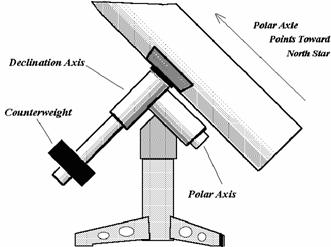A Balanced GEM
Jack Kramer
No, this has nothing to do with jewelry; we're referring to a German Equatorial Mount (GEM for short). While this type of mount can be awkward and unstable if not well executed, a good one is the most useful equatorial mount for telescopes with long tubes and is the easiest to balance properly. For this reason, they're standard equipment on many telescope systems. Even some users of the short-tubed SCTs convert from the common fork to a GEM if they will be hanging a lot of accessories off their scopes. But getting the best performance from a GEM requires "finessing" the adjustments. Here are a few suggestions.
On a German equatorial mount, how large a counterweight (c/w) will you need for a given telescope weight and where should it be placed? The formula is:
(Scope weight) x (scope-to-mount distance) / (c/w weight) = c/w-to-mount distance
 Let's assume the scope and accessories weigh 30 pounds and the center of the tube is 4" from the GEM mount head. We'll also assume there's a 10-lb. counterweight supplied with the scope.
Let's assume the scope and accessories weigh 30 pounds and the center of the tube is 4" from the GEM mount head. We'll also assume there's a 10-lb. counterweight supplied with the scope.
Plugging in the numbers:
(30 x 4) / 10 = 12 inches
Thus, in order to balance the scope, the counterweight should be about 12 inches down the declination shaft. You can use a heavier or lighter counterweight if you slide it up or down the declination shaft. Decreasing its distance from the center of the mount (that is, the RA axis pivot) will increase the weight needed to balance things.
Suppose you add a camera. Should you just slide the counterweight farther down the shaft to compensate for this added weight? While that would work, it's not necessarily the best thing to do. The closer the counterweight is to the equatorial head, the greater is the resonant frequency, so the tendency of the mount to vibrate is lessened. Also, with a counterweight closer to the mount, the mass is concentrated toward the equatorial head, which further helps reduce vibration. So the better solution is to get a heavier counterweight or an additional counterweight to stack with the original one. This will keep the counterweights farther "up" the shaft.
This is the same principle applied when people hang a weight directly under the mount head to reduce vibration.
Before starting to observe, we generally loosen the clutches on both axes, then adjust the counterweights and the telescope tube fore-and-aft in order to perfectly balance everything. This in effect creates a "neutral" balance so the telescope will stay put once we sight in on targets. However, there may be a better option if your GEM is motor-driven. A neutral balance may be the cause of backlash - a tendency to slip back slightly once you stop slewing to your target using the motor drive. More common is a failure of the drive to immediately engage when you attempt to activate the motors in one or more directions while guiding. You press a direction button on the drive controller and nothing happens right away. Often this is due to slack in the way the gears mesh, which is most noticeable at low speed where the slack has to be taken up before the gears fully engage. One solution is to "load" the gears just a bit; that is, keep some pressure on them. To do this, your scope should be slightly unbalanced against whatever direction you most often need to adjust the drive. This forces the gears to be always fully engaged and working to overcome this imbalance. Of course, make sure that the gears are meshing correctly to begin with; most mountings have a provision for this adjustment. If your mount does not appear to have any backlash, hesitation, or speed error problems, a neutral balance is just fine.
Loading the drive has also been recommended as a way to optimize tracking accuracy. To reduce speed variations in right ascension, keep the telescope very slightly off balance toward the east, which forces the motors to work just a bit harder, but at a steadier speed.
Make sure any off-balance condition is very slight - not great enough to force the motors to overheat...unless you want to buy new motors for your mount! To that end, here are some comments about motor failures from Peter Ward, who sells and services telescope mounts for a firm in Australia: "Motors will fail if they run hot for extended periods (140C for 30 minutes will do it!) Most common causes of failure - mount out of balance, worm mesh too tight, too much payload, running the system at wrong voltage, bad motor cable connection(s), failed on/off switch. Most common thing you must not do - unplug/plug a live motor cable. Most common thing that wasn't your fault - static electricity zap (beware dry winter nights!) Most common thing you did not do - fully read the manual."
Published in the July 2006 issue of the NightTimes




